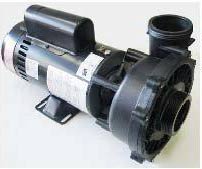Hot Tub Pumps and Heaters
 Hot Tub Pumps and heaters are some of the hot tub components that can be easily sourced online and readily replaced.
Hot Tub Pumps and heaters are some of the hot tub components that can be easily sourced online and readily replaced.
Troubleshooting a hot tub pump or heater problem means isolating the fault to the actual component causing the problem.
Service technicians discover faulty hot tub parts based on the concept of upstream or downstream troubleshooting. This means unplugging components and then plugging them back in one by one until a fault can be found.
You can find a wide variety of hot tub pumps and heaters online including main spa pumps, circulation pumps, air blowers, spa heater elements, complete spa heaters and complete spa packs.
 Hot Tub Heaters are available either as just the heater element that fits inside the heater tube, or the complete heater assembly with unions that connect to the spa plumbing.
Hot Tub Heaters are available either as just the heater element that fits inside the heater tube, or the complete heater assembly with unions that connect to the spa plumbing.
Heater elements are also referred to as flow through heater elements. There are also hairpin style elements, ones with screwplugs or coil heater elements.
The heater tube is also called a heater manifold and they are flow through type devices that contains the heater element. Sometimes the heater manifold also contains sensors for newer Balboa spa packs and other hot tub control systems.
Hot tub heaters are available in a wide variety of shapes and sizes.
![]() Buy hot tub replacement parts online.
Buy hot tub replacement parts online.

The hot tub pump is made up of a wet end where the spinning impeller driven by the pump motor turns the water similar to a water wheel. The other section of the pump is the pump motor.
The pump has two openings referred to as pump suction and pump discharge. As the names imply, the pump sucks water in from the suction and presses out water through the discharge.
As long as there are no air pockets in the pump, the water is moved forcefully and evenly through the plumbing.
Pump motors are available in several different configurations including operation for 120 volts or 230 volts and also either 50 hz or 60 hz operation.
Jacuzzi hot tub heaters are made by several different manufacturers. Vulcan electric, Hayward and Balboa are some of these electric spa heaters.
Many heaters are relatively easy to install although any hot tub electrical work should be referred to qualified technicians.
Hot tub heaters are rated in kw or kilowatts with 3kw, 4kw and 5kw heaters being the most popular due to voltage requirements and limitations.
Hot tub heaters are succeptable to the build up of calcium deposits and other deposits as the water continuously flows across the heater element. If hot tub water quality is not maintained, deposits can form on the heater element causing the spa to have to work harder in order to heat the water and eventually causing problems with either the heater or spa pump.
For this reason, hot tub heaters are one of the primary hot tub components to fail, especially on hot tubs where the water quality has not been maintained. Allowing the pH of the water to remain outside of the ideal range of 7.2-7.6 can greatly increase the chance of heater failure.
The initial symptoms of a broken spa heater are the inability of the spa to maintain spa temperature or the excessive cycling of the spa as it continuously tries to heat the water to the set temperature.
Titanium heaters are considered more robust than their predecessors, but even if the heater coil, element and tube are made of the best materials, poor water quality is the number one reason why these components can fail.
The time it takes a service tech to replace a hot tub pump is usually only 5-10 minutes as they are unbolted from the spa floor or pad, unplugged from the electrical components or spa pack and unmounted from the spa plumbing, usually by opening a removable pump union.
When replacing spa pumps, the pump union seal is also usually replaced to assure a leak-free connection. Do not overtighten the nut when replacing the pump to avoid cracking the union. These are typically hand-tightened with possibly a slight additional twist with a large pipe wrench, pliers or channel locks.
Hot Tub Spa.ca